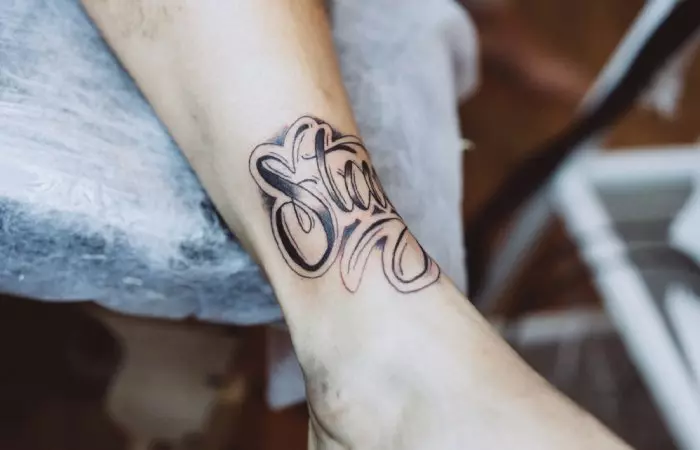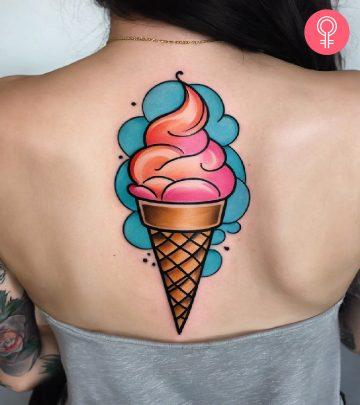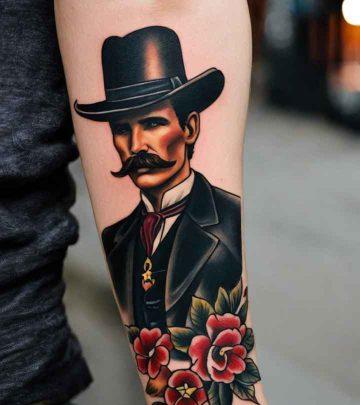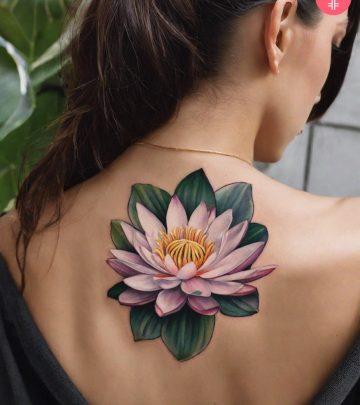Do Ankle Tattoos Hurt? How To Reduce The Pain?
Learn the nitty-gritty of ankle tattoo aftercare and pain management!

Image: Shutterstock
How bad do ankle tattoos hurt? That is the first question that pops into the mind of everyone contemplating a cutesy ankle tattoo for the first time. Ankle tattoos look absolutely gorgeous when done right. But getting a permanent piece of body art does come with its fair share of pain. The ankles are definitely not the easiest body part to get tattooed. In fact, it may be one of the most painful spots on the body to get a tattoo.
However, don’t worry. While you can expect some pain during the procedure, there are ways to deal with it. Moreover, if you have patience and a considerable pain tolerance level, you will be fine. This article goes into the details of how much ankle tattoos might hurt, how to deal with the pain, and ways to care for your tattoo so that it heals properly. Scroll down to learn more.
In This Article
Ankle Tattoo Pain Levels
Understanding what a tattoo feels like can help you prepare for the sensation, especially when opting for delicate areas like ankle tattoos. It is important to understand that the discomfort of getting tattooed varies depending on where you get it done and the tolerance capability of an individual. Experienced tattoo artists and people who have gotten ankle tattoos rate the pain level a four out of five on the tattoo pain scale. This is because the ankle area has thinner layers of skin, and there is not much flesh and fat to cushion the bones in case of an injury. Moreover, the tendons and the nerves on the ankle and foot area are closer to the surface. Hence, it hurts more when the tattoo needle strikes near the ankle bones and the tattoo ink is injected.
The ankles are one of the most painful tattoo spots to get foot tattoos. Therefore, it requires higher individual pain tolerance to endure the pain level during the tattooing process. Many back out, use numbing creams or topical anesthetics, or resort to painkillers or alcohol to bear the pain caused while getting ankle tattoos done.
That said, the answer to the question, “Do ankle tattoos hurt?” can be a bit nuanced. Apart from individual tolerance levels, which vary, the exact location on your ankle you select for tattooing influences the pain level you may experience. You may refer to a tattoo pain chart that can help you gauge the potential pain levels of ankle tattoos with those of other sensitive areas. Therefore, before you book your tattoo appointment, look at some common ankle tattoo spots below:
1. Inner Ankle

It is the fleshiest part of the ankle. The inner ankle is a less sensitive spot, so the inner ankle tattoo pain is comparatively less. Therefore, it is one of the least painful locations for tattoos and an appropriate option for those with low pain tolerance levels and seeking a tattoo experience with the least amount of pain.
2. Outer Ankle
The outer ankle has thinner skin close to the bones. This area has more delicate nerve endings and lacks muscles and fat. Tattoos on the outer ankles come with a heightened sense of discomfort due to the tattoo needle continuously poking the bony area.
3. Back Of The Ankle
Tattoos on the back of the ankle are significantly less painful and are a great option for people who want matching ankle tattoos. They are also less prone to fading.
4. Front Ankle

Tattoos on the front of the ankle are most striking. However, they are more painful than the ones at the back. While small, minimal designs may hurt less, bigger or more intricate designs would result in an intense experience.
5. Above The Ankle
The area falls between the lower calf and upper ankle. It can be a great choice for medium-sized pieces concentrated around the lower calf area and less intricate tattoo designs near the ankle.
Jade, a blogger and tattoo enthusiast, shares her experience of getting her tattoos on her personal blog. In one of them, she reveals the pain tolerance level in different parts of her leg, “I would rate the pain for my leg around a 4/10. It was stingy in places like closer to my knee and ankle, but in the middle, it was absolutely fine. And for my foot 8/10 because I have really bony feet so it was stingy pretty much all over (i).”
6. Around The Ankle

The pain during a tattoo around the ankle is variable as the skin on every side has a different pain threshold. It makes for one of the most loved spots for foot tattoos, and tribal or floral anklets are the most popular designs.
Along with the location, other factors like the tattoo size and individual pain tolerance may also determine how much pain one may experience during the tattooing process. Generally, smaller tattoos tend to be less painful, while larger or more intricate designs may cause more discomfort due to the extended time spent under the needle and the increased amount of work involved. Further, if you have a higher pain tolerance, you may experience less discomfort. Otherwise, the experience could be more challenging.
 Quick Tip
Quick TipGetting tattoos anywhere on the foot is going to hurt. However, learning more about the different pain levels associated with foot tattoos in different locations, especially on the ankle may help you prepare mentally. It will help you take precautions to deal with the pain beforehand, ensuring a better tattoo experience. In the next section, we discuss steps to create an optimal condition for your body to reduce pain during a tattooing session.
Key Takeaways
- Ankle tattoos are one of the most painful tattoos to get due to the thin skin and proximity of the nerve endings and bones to the surface of the area.
- The exact placement of the tattoo on the ankle may influence the level of pain. A tattoo on the inner ankle hurts less than one on the outer ankle.
- Good sleep and hydration before a tattoo session may help reduce the pain.
- Ankle tattoo aftercare is crucial. Raising the ankle and keeping the area clean helps with the swelling and aids in healing the wound, respectively.
How To Reduce Ankle Tattoo Pain
Our body has its mechanism to deal with pain. The first few minutes of trauma to the skin are the most painful. It’s our body’s way of telling us that something damaging is happening to the area. After that, the body starts to get acclimated to it and often releases hormones that help reduce the pain. However, there are a few things that you can do to reduce the level of pain you feel during or before a tattoo session:
- Sleep well before your tattoo session to ensure your body is well-rested. A tired body may become more sensitive to pain.
- Drink plenty of water to keep your body hydrated. It may help you deal with the pain. Moreover, hydrated skin may absorb the tattoo ink better.
- Eat a healthy and satiating meal before your session to let your body restock energy.
- Skip alcohol at least 24 hours before your appointment, as it might interfere with the healing process and increase the risk of infection (2).
- Don’t take painkillers or blood thinner before tattooing, as they may increase the risk of bleeding.
- Use a numbing cream or topical anesthetic to reduce the pain at the tattoo studio.
- You may also apply ice on the area for at least five minutes before the session. Ice has a numbing effect on the skin and may help with pain management.
 Quick Tip
Quick TipIf you have low pain tolerance levels and still want ankle tattoos, better opt for minimal designs. Larger tattoos with intricate designs and colors on the ankle area are likely to hurt more as they require much more time to execute. Moreover, smaller tattoos will heal faster.
Tattoo aftercare is a crucial stage in the healing of your perfect tattoo and requires proper attention. Let us move on to the next section to learn more about ankle tattoo aftercare.
Ankle Tattoo Aftercare
If you have come this far, you have endured the intense pain level of an ankle tattoo, so kudos to you! Now, the aftercare following the tattoo procedure is extremely important as you do not want to mess up your dream tattoo because of an infection or an allergic reaction. Here are some important aftercare steps to follow:
1. Elevate Your Ankle

Elevating your ankles whenever you get a chance will help reduce the swelling in the tattooed area. It will also ease the tenderness in the skin temporarily.
2. Avoid Tight Clothing
Preventing friction in the tattooed area is crucial for a quick and healthy recovery. Avoid wearing tight clothing in your lower body to help the tattooed area heal better without any disturbance.
3. Wear Proper Footwear
For the first two weeks after the tattoo process, avoid wearing shoes and socks that go above or the same level as your tattoo to avoid irritating your skin.
4. Maintain Hygiene
Ankle tattoos are likely to be closer to the ground and prone to infection due to exposure to dirt and microorganisms. Clean the area at least twice a day, as per the instructions of the tattoo expert.
5. Use A Cold Compress

Use ice or cold compresses if you are experiencing intense pain, redness, or swelling around your tattoo to soothe the area.
6. Avoid Hot Water
Take quick cold showers after getting your ankle tattoo done, as exposing the tattoo to water for an extended period of time may irritate the open wound and delay the healing process.
7. Avoid Exposure To The Sun
Cover your tattoo
whenever you go outside and prevent it from exposure to direct sunlight. UV rays may fade the ink or damage the skin. Always use SPF if you must step out in the sun.
8. Stay Hydrated

Proper hydration or drinking plenty of water promotes skin healing (3). A tattoo is essentially an open wound, and keeping the body healthy and hydrated helps immensely in reducing intense pain.
However, ensure that you follow the aftercare instructions shared by the tattoo artist regarding how long to keep the dressing on and what products to use. Following the guidelines will ensure your ankle tattoo heals properly.
Ankle tattoos are extremely popular among women, as they accentuate the legs. However, there is no denying that the ankle is also one of the most painful spots to get a tattoo. People who want foot tattoos or ankle tattoos often find themselves wondering, “How painful are ankle tattoos?”. The pain level during tattooing around the ankle varies with the exact location of the tattoo. You may choose an area that suits your aesthetic sense and individual level of pain tolerance. However, taking certain steps, such as staying hydrated and sleeping well, may help you prepare your mind and body before the tattooing process, which may help you deal with the pain better. Also, you must get your tattoo in a professional setting and follow proper aftercare instructions from your skilled tattoo artist for a speedy recovery and better pain management.
Frequently Asked Questions
Are ankle tattoos good for beginners?
Yes, ankle tattoos are good for beginners, especially if you wish to get a small and simple tattoo that is easy to show off. However, you should remember that the area around the ankle is bony and has less flesh. So, you can still feel uncomfortable, especially if your pain tolerance is too low. In this case, you may opt for lesser painful areas like the outermost upper arm, forearm, thigh, or calf. However, they are also relatively less painless compared to other body parts like the ribs or spine.
What hurts more – a wrist or an ankle tattoo?
Ankle tattoos are generally considered to be more painful than wrist tattoos because the skin on the ankles is closer to the bones and that area has a higher concentration of nerve endings. However, it also depends on the tattoo placement and individual pain tolerance level.
Can you walk after getting an ankle tattoo?
Yes, you can. However, you will experience discomfort or pain due to swelling or friction. Therefore, it is best to avoid excessive motion just after getting the tattoo.
Do ankle tattoos age well?
Ankle tattoos usually age well. However, it depends on the ink quality and how you care for your tattoo as well.
Is the pain of an ankle tattoo manageable?
It depends. The pain of an ankle tattoo would be manageable for people who already have prior tattooing experience. Using numbing creams or topical anesthetics may also make the pain bearable. Since ankle tattoos are painful, it is advisable to start with a less painful area.
Do ankle tattoos hurt more for certain skin types?
Yes, skin type is one of the factors that influence the pain level during a tattoo. People with sensitive skin may experience more intense pain.
Illustration: Do Ankle Tattoos Hurt? How To Reduce The Pain?

Image: Stable Diffusion/StyleCraze Design Team
The following video provides an account of the experience of getting an ankle tattoo. To get insights into the tattooing process before you step out to get your own, check out the video below!
Personal Experience: Source
StyleCraze's articles are interwoven with authentic personal narratives that provide depth and resonance to our content. Below are the sources of the personal accounts referenced in this article.
(i). My tattoos, meanings, & pain ratings – Part 1https://crescentraven.wordpress.com/2018/03/11/my-tattoos-meanings-pain-ratings-part-1/
References
Articles on StyleCraze are backed by verified information from peer-reviewed and academic research papers, reputed organizations, research institutions, and medical associations to ensure accuracy and relevance. Read our editorial policy to learn more.
- Dehydration enhances pain-evoked activation in the human brain compared with rehydration
https://pubmed.ncbi.nlm.nih.gov/24384865/ - Factors Affecting Wound Healing
https://www.ncbi.nlm.nih.gov/pmc/articles/PMC2903966/ - The importance of hydration in wound healing: reinvigorating the clinical perspective
https://www.hartmann.info/sitecore/service/notfound.aspx
Read full bio of Bianca Lorena Saldes
Read full bio of Gazala Firdos Ansari
Read full bio of Subhrojyoti Mukherjee
Read full bio of Shreya Mukherjee



























Community Experiences
Join the conversation and become a part of our empowering community! Share your stories, experiences, and insights to connect with other beauty, lifestyle, and health enthusiasts.